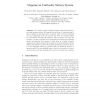Free Online Productivity Tools
i2Speak
i2Symbol
i2OCR
iTex2Img
iWeb2Print
iWeb2Shot
i2Type
iPdf2Split
iPdf2Merge
i2Bopomofo
i2Arabic
i2Style
i2Image
i2PDF
iLatex2Rtf
Sci2ools
FUN
2010
Springer
2010
Springer
Mapping an Unfriendly Subway System
We consider a class of highly dynamic networks modelled on an urban subway system. We examine the problem of creating a map of such a subway in less than ideal conditions, where the local residents are not enthusiastic about the process and there is a limited ability to communicate amongst the mappers. More precisely, we study the problem of a team of asynchronous computational entities (the mapping agents) determining the location of black holes in a highly dynamic graph, whose edges are defined by the asynchronous movements of mobile entities (the subway carriers). We present and analyze a solution protocol. The algorithm solves the problem with the minimum number of agents possible. We also establish lower bounds on the number of carrier moves in the worst case, showing that our protocol is also move-optimal.
| Added | 19 Jul 2010 |
| Updated | 19 Jul 2010 |
| Type | Conference |
| Year | 2010 |
| Where | FUN |
| Authors | Paola Flocchini, Matthew Kellett, Peter C. Mason, Nicola Santoro |
Comments (0)

